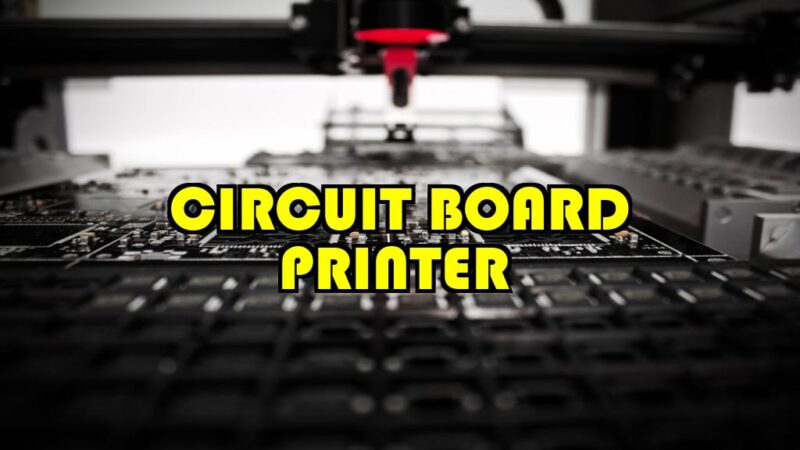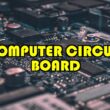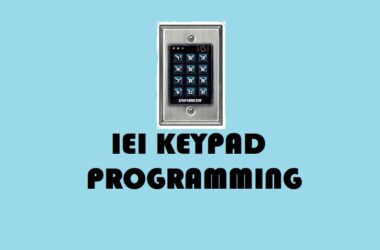In the world of electronics manufacturing, a circuit board printer is the heart of innovation. Our aim is to provide an expert guide. We will discuss circuit board printers, exploring the key components, cutting-edge technologies, and the indispensable role they play in electronic devices.
Understanding the Core: What is a Circuit Board Printer?
A Circuit Board Printer is a sophisticated device that prints the circuitry of electronic components onto a substrate, typically a fiberglass-reinforced epoxy resin board. This process involves precision, accuracy, and a synergy of advanced technologies to ensure the seamless creation of intricate circuits that form the backbone of electronic devices we use every day.
The Anatomy of Circuit Board Printer
Print Head Technology
At the forefront of circuit board printing lies the print head—a pivotal component responsible for translating digital designs into tangible circuits. Cutting-edge inkjet technology has revolutionized this , offering unparalleled precision and the ability to handle intricate designs with utmost accuracy.
Substrate Selection
Choosing the right substrate is similar to selecting the canvas for a masterpiece. Manufacturers now have an array of materials at their disposal, each with unique properties. Fiberglass-reinforced epoxy resin boards dominate the scene due to their durability, electrical insulation properties, and cost-effectiveness.
Inks and Materials
Precision in circuit board printing extends to the selection of inks and materials. Conductive inks, solder masks, and protective coatings are chosen to ensure longevity and reliability. The evolution of eco-friendly, lead-free materials aligns with the industry’s commitment to sustainability.
The Technological Leap: Advanced Features
3D Printing in Circuitry
The integration of 3D printing technology into circuit board printing is an approach that revolutionizes the traditional two-dimensional circuitry by introducing the concept of three-dimensional circuit printing.
Traditionally, electronic circuits have been confined to flat, planar surfaces, limiting the design possibilities and sometimes making difficult the quest for more compact and efficient electronic devices. However, with 3D printing in circuitry, this pattern is shifting. The technology allows for the creation of three-dimensional structures within the circuitry itself.
This three-dimensional aspect brings several advantages to the table:
- Space Efficiency: 3D-printed circuitry enables a more efficient use of space within electronic devices. Traditional flat circuits often leave unused gaps or require intricate folding to fit into compact spaces. With 3D printing, circuits can be designed to occupy three-dimensional spaces efficiently, contributing to the miniaturization of electronic components.
- Enhanced Performance: The ability to create complex three-dimensional structures within the circuitry opens avenues for optimizing performance. Components can be strategically placed and interconnected in ways that were previously impossible with traditional flat circuit designs. This enhanced arrangement contributes to improved signal integrity and overall device performance.
- Innovative Design Possibilities: The marriage of precision and creativity in 3D printing technology allows for unprecedented design flexibility. Engineers and designers can explore novel shapes and configurations, tailoring circuitry to the specific needs of a device. This not only serves functional purposes but also contributes to a more aesthetically pleasing and innovative product design.
- Rapid Prototyping: 3D printing in circuitry facilitates rapid prototyping, allowing manufacturers to quickly iterate and test different design concepts. This agility in the design process accelerates product development cycles, ensuring that innovative ideas can be brought to market faster than ever before.
IoT Integration
The integration of the Internet of Things (IoT) into circuit board printing signifies a crucial adaptation to the evolving landscape of technology. In an era where IoT is becoming increasingly ubiquitous, circuit board printers are playing a pivotal role in meeting the demands of a connected world.
The essence of IoT lies in the interconnectivity of devices and the exchange of data between them. Circuit board printers are adapting to this paradigm shift by incorporating features that facilitate seamless communication and integration of electronic devices into the broader IoT ecosystem.
Here’s a detailed breakdown of how IoT integration in circuitry enhances functionality and contributes to the expanding realm of smart technology:
- Interconnected Devices: With IoT integration, circuit boards are designed to enable devices to communicate with each other. This interconnectedness allows for the creation of smart systems where devices can share information, collaborate, and respond dynamically to changing conditions. For example, in a smart home setup, circuitry enables various devices such as thermostats, lights, and security systems to communicate and work in harmony.
- Data Exchange and Analysis: IoT-enabled circuitry facilitates the exchange of data between devices. This data can include information about device status, usage patterns, and environmental conditions. By capturing and analyzing this data, IoT-equipped devices can make informed decisions, optimize performance, and provide valuable insights to users.
- Remote Monitoring and Control: IoT integration empowers users to monitor and control connected devices remotely. Circuit boards with IoT capabilities enable functionalities like remote access to home security cameras, adjustment of smart thermostats, or even monitoring the status of industrial equipment. This not only enhances convenience but also contributes to energy efficiency and overall system management.
- Enhanced Automation: IoT-integrated circuitry enables automation of processes based on real-time data. Devices can respond to predefined triggers, automating tasks without direct human intervention. For instance, in industrial settings, machinery equipped with IoT-enabled circuitry can adjust operations based on performance data, optimizing efficiency and reducing downtime.
- Scalability and Adaptability: Circuit board printers are evolving to accommodate the scalability and adaptability requirements of IoT. This ensures that as the number of connected devices grows, the circuitry can handle the increased complexity and data flow. Scalable IoT integration is crucial for future-proofing devices and systems in an ever-expanding IoT ecosystem.
ALSO READ: 3 Best Circuit Board Cleaner for Superior Results
Future Trends in Circuit Board Printers
Machine Learning and AI Integration
The future of circuit board printing is intertwined with the realms of machine learning and artificial intelligence. These technologies optimize the printing process by predicting potential errors, enhancing efficiency, and adapting to evolving design complexities.
Customization and Prototyping
In the current era, where innovation is a driving force in technology, circuit board printers have emerged as versatile tools, mastering the art of customization and rapid prototyping. This newfound agility is empowering manufacturers to translate their conceptual ideas into tangible realities with unprecedented speed, thereby significantly expediting the product development lifecycle.
1. Tailored Circuit Designs:
Circuit board printers have evolved to offer manufacturers the ability to create highly customized circuit designs. This tailoring extends beyond mere layout adjustments; it allows for the precise adaptation of circuits to meet the unique requirements of specific applications. Whether it’s optimizing performance for consumer electronics, medical devices, or industrial machinery, the customization capabilities of circuit board printers ensure a perfect alignment with the intended use.
2. Flexible Form Factors:
The demand for compact and diverse device designs is met through the flexibility offered by circuit board customization. Manufacturers can now design flexible and bendable circuits, accommodating the specific contours of devices. This flexibility is particularly crucial in applications such as wearable technology, where traditional rigid circuitry might be impractical.
3. Material Selection:
Customization also extends to the selection of materials employed in the circuitry. Manufacturers can strategically choose materials based on desired attributes like conductivity, heat resistance, and environmental considerations. This not only enhances the overall performance of the circuit but also contributes to the durability and reliability of the final product.
ALSO READ: What Is Computer Circuit Board And How Does It Work: Expert Guide
Industry Insights: Outpacing the Competition
In the dynamic landscape of electronics manufacturing, staying ahead is not merely an advantage but a necessity. Our comprehensive guide to circuit board printers equips manufacturers and enthusiasts alike with the knowledge needed to outpace the competition. By embracing the latest technologies, understanding the intricacies of the printing process, and anticipating future trends, success in the electronics industry becomes not just a goal but a tangible reality.
Conclusion
In conclusion, circuit board printers stand as the heroes behind the electronic devices. Our guide has explained the details of these devices, from the precision of print head technology to the integration of 3D printing and the embrace of AI. One thing is clear—understanding the power of circuit board printers is very important.









